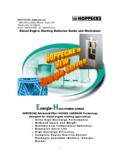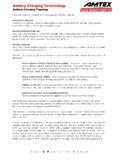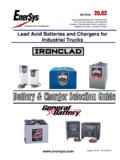Transcription of Diesel Engines for NFPA-20 Fire Protection …
1 Cincinnati, Ohio USA - Glasgow, Scotland UK. Diesel Engines for NFPA-20 fire Protection applications nfpa 20 Engine Type Diesel Engines for fire pump drive shall be of the compression ignition type. Spark-ignited internal combustion Engines shall not be used. ( natural gas, propane or gasoline). nfpa 20 - Engine Ratings Rated at SAE Conditions 25 C (77 . F ) and 91 m (300 ft ) above sea level. Engines must have at least a 10% reserve in horsepower. (This is a UL-FM. requirement and all UL-FM engine ratings reflect this requirement). Engines must be derated for Altitude and Temperature. 3% Derate for every 300 m (1000 ft ) above 91. m (300 ft ). 1% Derate for every.
2 C (10 F ) above 25 C. (77 F ). nfpa 20 Instrument & Control Engines shall be regulated to have no more the 10% speed difference between shutoff and maximum load. (Defined as droop). Engines shall be provided with an overspeed shutdown at 20% above rated engine speed with a manual reset. (Only overspeed shutdown or a signal from the Diesel controller will shut down an engine.). Derate Example 150 hp engine Altitude 5,000 ft: CA=.86. Temperature 105F: CT=.973. Formula: (CA + CT 1) x hp = derated hp (.86+.973-1)=.833 x 150 hp = hp Clarke Selection/Derate Calculator program can calculate the exact size engine you need to use. Overspeed Setting Verification To verify the engine overspeed setting and function without overspeeding the engine, follow this procedure: Start engine manually from the controller while holding the overspeed verification switch in the up'position.
3 Observe the shutdown RPM. Test switch returns to normal position when released. Reset the overspeed switch on the engine instrument panel and restart the engine from the controller to verity normal operation. EXAMPLE: Rated engine speed: 2100 rpm Overspeed setting: 2520 rpm (120% 2100 rpm). Verification shutdown: 1688 rpm (67% of 2520 rpm). JU and JW Series Instrument Panel nfpa 20 Instrumentation & Control Required Gauges: Tachometer indicates rpms Oil Pressure Gauge Coolant Temperature Gauge Hour meter record engine run time Additional Gauges: Two voltmeters one for each set of batteries nfpa 20 Instrumentation & Control The engine instrument panel shall not be used as a junction box or conduit for any ac supply.
4 Interconnections between the automatic controller and engine junction box shall be made using stranded wire sized on a continuous-duty basis. The dc interconnections between the automatic controller and engine junction box and any ac power supply to the engine shall be routed in separate conduit. nfpa 20 Instrumentation & Control Main battery contactors supplying current to the starting motor shall be capable of manual mechanical operation to energize starting motor. Manual toggles are provided on the Clarke instrument panel and additionally manual start contactors for only the JW6H & JX6H. series Engines .). Clarke electric starting standard;. One (1) starter on JW6H, JX6H units.
5 Two (2) starters on JU4H, JU6H units. nfpa 20 Instrumentation & Control Electronic Engines Engines with an electronic control module (ECM) shall have an alternate ECM wired to produce full power in the event of primary ECM failure. There shall be a single ECM Selector Switch, with no off position, to transition from the primary ECM to the alternate ECM. A visual indicator shall show when the engine is running with the alternate ECM. (On both the engine panel and on the Diesel controller). JX Series Instrument Panel nfpa 20 Instrumentation & Control Electronic Engines Any sensor necessary for the function of the ECM shall have a redundant sensor that shall operate automatically in case of failure.
6 A signal shall be provided to the Diesel controller for fuel injector failure, low fuel pressure and any primary sensor failure. nfpa 20 Instrumentation & Control Each engine shall be provided with two storage battery units. Electrolyte shall be added to the batteries a minimum of 24 hours prior to the time the engine has to be started. At C (40 F ) each battery shall have twice the capacity sufficient to maintain 3. minute attempt-to-start cycle (15 seconds of cranking and 15 seconds of rest in six consecutive cycles). nfpa 20 Instrumentation & Control Storage batteries shall be rack supported above the floor to prevent water damage. Storage batteries shall be readily accessible for servicing.
7 Storage batteries shall not be located in front of the engine mounted instruments and controls. nfpa 20 Instrumentation & Control There should be two means for recharging the storage batteries. The battery chargers in the Diesel controller is the primary source. The alternator on the engine is the secondary source. nfpa 20 Engine Cooling The engine cooling system shall be of the closed-circuit type. Heat exchanger type Radiator type nfpa 20 Engine Cooling Cooling water shall be piped through a threaded rigid pipe from the discharge of the pump to the inlet of the heat exchanger. It is not permitted to use flexible tubing attached to the cooling loop.
8 nfpa 20 Engine Cooling The outlet for the wastewater coming from the heat exchanger shall be one size larger then the inlet. The wastewater shall be discharged into a visible open waste cone. Discharge can be piped to a suction reservoir provided a visual flow indicator and temperature indicators are installed. nfpa 20 Engine Cooling Heat exchanger standard equipment. Sea water or fresh water; sacrificial anode optional. Engines are shipped without coolant. Cooling water line (cooling loop) shall have a manual by-pass. Cooling water line and by-pass shall include: indicating manual shutoff valve approved flushing-type strainer pressure regulator automatic valve second indicating manual valve or check valve pressure gauge Cooling Water Line Engine Coolant Water, ethylene glycol, inhibitor coolant mixture.
9 50% water 50% coolant. Coolant to conform to ASTM D4985. Heat transfer Corrosion resistance Prevents scale and sludge build up Provides freeze and boil over Protection Pre-mix before installing in engine to prevent premature engine heater failure. nfpa 20 Engine Cooling Coolant heater is the only AC power on engine; Separate AC junction box required. Do not use controller AC for power supply. Add coolant mixture before applying AC. power. All heaters single voltage; Optional AC. voltages available - location specific. Engine coolant maintained at 49 C (120 . F ). nfpa 20 Engine Protection The engine shall be protected against possible interruption of service through explosion, fire , flood, earthquake, rodents, insects, windstorm, freezing, vandalism and other adverse conditions.
10 Application: The engine must be installed inside or protected from the weather and low temperature. nfpa 20 Room Requirements Rooms containing fire pumps shall be free from storage & penetrations not essential to the operation of the pump. Floors shall be pitched for adequate drainage of escaping water from critical equipment. The pump room shall be provided with a floor drain that will discharge to a frost free location. nfpa 20 Air Requirements The minimum ambient temperature for the pump room is C (40 F ). The maximum temperature for the pump room is 49 C (120 F ) at the air cleaner inlet with the engine running at rated load. nfpa 20 Air Requirements Inlet louver and ventilating system must: Maintain 49 C (120 F ) in the room Supply adequate air for engine combustion Adequate air for ventilating radiated heat.





